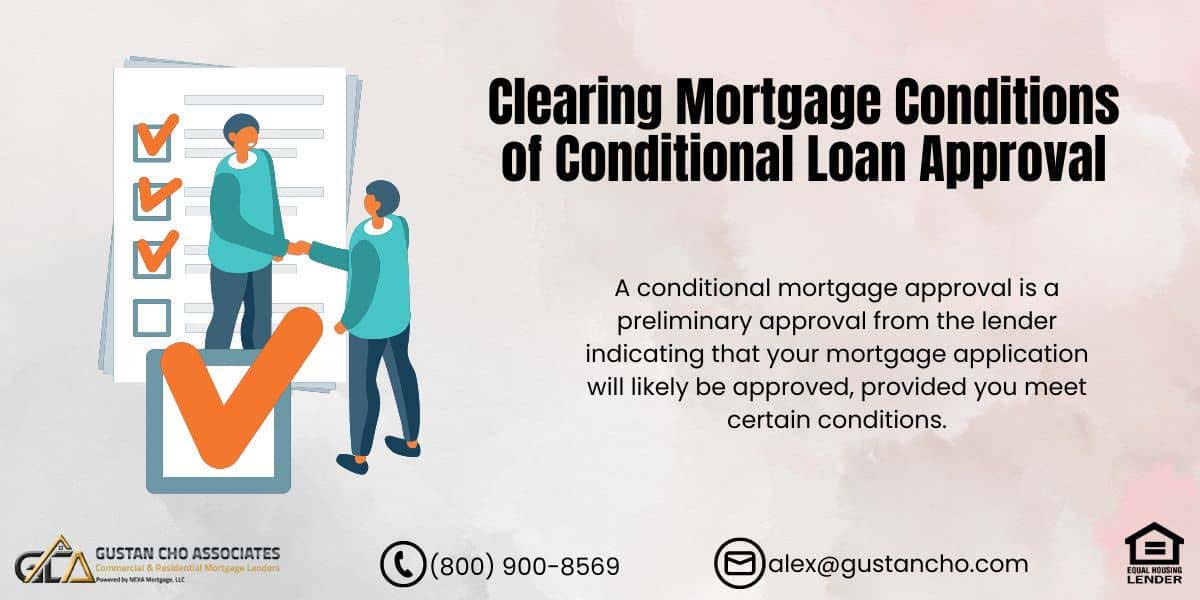This guide covers clearing mortgage conditions of conditional loan approval. After borrower’s mortgage application has been processed and underwritten, the mortgage underwriter will issue a conditional mortgage approval. Clearing Mortgage Conditions is required for the underwriter to issue a clear to close.
A conditional mortgage approval is a letter of intent that the lender will issue a clear to close as long as the clearing mortgage conditions can be met by borrowers.
Many times, the process up to the conditional loan approval is easy. It is clearing mortgage conditions that can be stressful. This is the period where it can drive both the borrower, processor, and loan officer crazy. The mortgage underwriters issue mortgage conditions. Most conditions are reasonable, and clearing mortgage conditions should not be stressful—the key to having as few conditions as possible.
What Are Clearing Mortgage Conditions on a Conditional Loan Approval
Conditional loan approval is a stage in the loan application process where a lender reviews the borrower’s application and financial information and provides a preliminary approval for the loan, subject to certain conditions being met. These conditions typically include providing additional documentation, meeting specific requirements, and fulfilling certain criteria.
What Are Common Conditions on Conditional Loan Approval
Clearing mortgage conditions for a conditional loan approval might include income and employment verification. The lender may require recent pay stubs, tax returns, or other documents to confirm the borrower’s income and employment status. The lender might review the borrower’s credit report again to ensure their credit score and history remain consistent.
For real estate loans, the lender may require an appraisal to assess the value of the property being used as collateral.
Meeting all the conditions is crucial for securing the loan. Borrowers should work closely with the lender, promptly providing any requested documents and addressing any concerns to increase the likelihood of obtaining the final loan approval. Additional documents such as bank statements, asset statements, and other relevant financial information may be requested. The lender may require proof of insurance coverage if the loan involves collateral, like a car or property.
Got Conditional Loan Approval? Let Us Help You Clear the Conditions and Close Faster!
Contact us today to get guidance on clearing your loan conditions and moving forward to closing.
What Happens After Conditional Loan Approval?
After receiving conditional loan approval, you need to satisfy specific conditions set by the lender. This typically involves providing additional documentation like updated income statements, employment verification, or proof of assets. Once you submit the required documents, the underwriter will review them.
If everything meets the lender’s requirements, you will receive final approval. You will receive a Closing Disclosure before the closing, detailing the ultimate loan terms and expenses at least three business days before the closing.
You will sign the final documents on the closing date and pay any closing costs. The loan funds will be disbursed, making you the official owner of the property. After closing, the lender will set up your mortgage account, and you will start making payments according to the agreed schedule. Maintaining open lines of communication with your lender and promptly submitting all required documents will facilitate a seamless process.
Satisfactory Property Conditions
If the loan involves real estate, the property may need to meet certain standards or undergo repairs before final approval. Once the borrower submits the required documentation and meets the specified conditions, the lender will review the information to ensure everything is in order.
For real estate loans, the lender might need to conduct a title search to ensure no property ownership issues.
If all conditions are satisfied, the loan will move forward to the final approval stage, and the borrower will receive a formal commitment letter detailing the loan terms. Borrowers need to understand that conditional approval does not guarantee final approval.
What Does it Mean When a Loan is Approved with Conditions?
When a loan is approved with conditions, the lender has given preliminary approval to your loan application. However, certain requirements must be met before the loan can be fully approved and funded. Typically, these conditions are necessary to satisfy the lender’s criteria. Common conditions may include:
- Providing Additional Documentation: The lender may request further documents such as updated income statements, tax returns, bank statements, or proof of employment.
- Clearing Up Any Discrepancies: You must provide explanations or additional information if there are any inconsistencies or questions about your financial situation or documentation.
- Property-Related Conditions: These may include providing a satisfactory appraisal report, a home inspection report, or proof of homeowners insurance.
- Meeting Financial Requirements: You may be required to settle specific debts, demonstrate your funds for the down payment, or enhance your credit score.
- Verification of Information: The lender may need to validate the information provided by contacting your employer to confirm your employment status and income.
Once you fulfill all these conditions, the lender will conduct a final review. If everything is in order, the lender will issue final loan approval, and you can proceed to the closing process to finalize the loan.
Conditional Loan Approval? We’re Here to Help You Clear Those Conditions and Close!
Reach out now to learn how we can help you clear the necessary conditions and get you to the closing table.
The Importance of Submitting Complete Documents During Submission
There will be less clearing mortgage conditions on files that have been properly submitted. To get as few conditions as possible, ensure the processor submits a complete mortgage application package to the underwriter.
The mortgage processor often might skip certain items because they have not gotten documents back from the borrower.
Any items that have not been submitted will come back as mortgage conditions, which could lead to delays in closing the mortgage loan. This article will discuss and cover clearing mortgage conditions after conditional loan approval. During the conditional loan approval stage, the lender evaluates the borrower’s creditworthiness, income, employment history, and other relevant factors to determine if they meet the criteria for the loan. If the borrower satisfies these initial requirements, the lender will issue a conditional approval outlining the terms and conditions under which the loan will be granted.
Clearing Mortgage Conditions Is What Causes Delays In CTC
The main cause for delays in getting a mortgage clear to close is mortgage conditions. The key to meeting the closing date deadline by getting a quick clear to close is to ensure that the mortgage loan application has been processed as completely as possible the first time around. Borrowers should get the necessary documents, such as the following:
- Two years tax returns, two year’s W-2s
- Most recent paycheck stubs
- Two months bank statements
- letters of explanations for credit inquiries
- bankruptcy, foreclosure
- deed-in-lieu of foreclosure
- short sale
- 401k statements
- investment accounts
- divorce decree
- letters of explanations for derogatory accounts
Other documents requested by the mortgage loan originator. Any missing documents not submitted with the initial mortgage documents will be conditioned on the initial conditional mortgage approval.
What is a Conditional Mortgage Commitment?
A conditional mortgage commitment is a formal letter from a lender stating that your mortgage application has been reviewed and is likely to be approved, provided you meet certain specified conditions. It signifies that the lender will lend you the money for your home purchase, subject to fulfilling these requirements. The conditions typically outlined in the commitment letter may include:
- Additional Documentation: The lender may require more documents, such as recent pay stubs, updated bank statements, or additional tax returns.
- Property Appraisal: The home must undergo an appraisal to ensure it meets the lender’s criteria for value and condition.
- Employment Verification: The lender must confirm your present employment and income.
- Credit Check: The lender might require an updated credit report or a certain credit score.
- Debt Payment: You may need to pay off specific debts to qualify for the mortgage.
- Insurance: Proof of homeowners insurance may be required before closing.
- Legal and Title Issues: Any legal or title issues with the property must be resolved.
Meeting these conditions is crucial for progressing to final loan approval. Once all conditions are satisfied, the lender will issue a final commitment, and you can proceed to the closing process to finalize your mortgage.
Ready to Close Your Loan? Let Us Help You Clear Your Conditional Loan Approval Conditions!
Contact us now to get the support you need in clearing your mortgage conditions.
Conditional Mortgage Loan Approval
Once borrowers get conditional loan approval, the underwriter will request a list of mortgage conditions. The next step is clearing mortgage conditions. All conditions must be met and submitted to the underwriter for the underwriter to issue a clear-to-close.
It is the processor’s job to get the necessary conditions either by requesting it directly from the borrower or requesting it through the loan originator. It is not uncommon to have a line item of over 20 conditions.
The key is to get all the conditions and re-submit them to the underwriter. Once conditions listed on the conditional approval are satisfied and submitted to the underwriter, it normally takes 24 to 48 hours for the underwriter to issue a clear-to-close. Or get borrowers an updated conditional loan approval.
Clearing Mortgage Conditions For UPDATED Conditional Approvals
Updated conditional loan approval means the underwriter did not get all the conditions. Or that the underwriter issued a fresh batch of conditions. Again, the underwriter will not sign off on a clear to close if the requested mortgage conditions are not submitted. This will cause a delay in getting a clear to close. Some mortgage underwriters will not reply for 48 to 72 hours after submitting conditions. So, every time conditions are submitted, and it is missing items, borrowers look at delays. Due to the delay factor, many veteran-experienced processors will not submit conditions even if they are missing just one minor item.
What is the Difference Between Conditional and Unconditional Mortgage Approval?
The difference between conditional and unconditional mortgage approval lies in the presence of specific conditions that must be met before the loan is fully approved. Conditional mortgage approval means the lender has reviewed your application and will approve the loan, provided you meet certain conditions.
These conditions may include additional documentation, employment verification, a satisfactory property appraisal, resolving any legal or title issues, or meeting specific financial requirements. Once you satisfy these conditions, the lender will conduct a final review before granting full approval. Only then will the loan be guaranteed.
On the other hand, unconditional mortgage approval means that the lender has reviewed and verified all necessary information and documentation, and no further conditions need to be met. There are no additional requirements or conditions to fulfill, and the loan is fully approved, allowing you to proceed directly to the closing process.
This stage typically occurs after all conditions of the conditional approval have been satisfied, and the lender is confident that all criteria have been met.
Conditional mortgage approval implies that certain requirements must be fulfilled before finalizing the loan. In contrast, unconditional mortgage approval suggests that all conditions have been met and the loan is prepared for closure.
Qualifying For a Mortgage With a Lender With No Overlays
The borrower may need to meet specific debt-to-income ratio requirements to ensure their ability to manage the new loan payments. Home Buyers who need to qualify for a mortgage with a lender with no overlays on government and conventional loans can contact us at Gustan Cho Associates Mortgage Group at 800-900-8569 or text us for a faster response. Or email us at gcho@gustancho.com.
FAQs: Clearing Mortgage Conditions of Conditional Loan Approval
- What is a Conditional Mortgage Approval? A conditional mortgage approval is a preliminary approval from the lender indicating that your mortgage application will likely be approved, provided you meet certain conditions. The lender’s letter of intent outlines the specific requirements you must fulfill to obtain final loan approval.
- What are the Common Conditions for Conditional Loan Approval? Common conditions include income and employment verification, providing additional documentation such as recent pay stubs, tax returns, bank statements, a satisfactory property appraisal, and resolving legal or title issues. These conditions ensure that the borrower’s financial status and the property’s value meet the lender’s criteria.
- What Happens After Conditional Loan Approval? After conditional loan approval, you must satisfy the lender’s specific conditions. This involves submitting the required documents, which the underwriter will review. If everything meets the lender’s requirements, you will receive final approval. You will then receive a Closing Disclosure detailing the final loan terms and expenses before the closing date. You will sign the final documents on the closing date and pay any closing costs. The loan funds will be disbursed, making you the official property owner.
- What is a Conditional Mortgage Commitment? A conditional mortgage commitment is a formal letter from the lender stating that your mortgage application will likely be approved, provided you meet specified conditions. These conditions may include providing additional documentation, undergoing a property appraisal, employment verification, a credit check, and resolving legal or title issues.
- What is the Difference Between Conditional and Unconditional Mortgage Approval? Conditional mortgage approval means the lender has reviewed your application and will approve the loan if you meet specific conditions. Unconditional mortgage approval means that all necessary information and documentation have been reviewed and verified, and no further conditions need to be met. The loan is fully approved, allowing you to proceed directly to the closing process.
- Why is Clearing Mortgage Conditions Important? Clearing mortgage conditions is crucial for securing the loan and moving towards final approval. It involves providing the necessary documentation and meeting the lender’s requirements. Failing to clear these conditions can delay or jeopardize the loan approval process.
- What Causes Delays in Clearing Mortgage Conditions? Delays can occur if the initial mortgage application package needs to be completed or documents must be included. Any items not submitted with the initial application will return as conditions, leading to potential delays. Ensuring the processor submits a complete application package can help minimize these delays.
- How Can Borrowers Ensure a Smooth Conditional Approval Process? To ensure a smooth process, borrowers should promptly provide any requested documents, maintain clear communication with the lender, and address any concerns quickly. Submitting a complete mortgage application package initially can help reduce the number of conditions and expedite the approval process.
- What Should Borrowers Do if They Receive Updated Conditional Approvals? Suppose the underwriter issues an updated conditional approval. In that case, it means some conditions were not met, or new conditions have been added. Borrowers should promptly address these conditions and resubmit the required documents. Delays can occur each time conditions are not fully satisfied, so it is essential to submit all requested items accurately and completely.
- How Can Borrowers Qualify for a Mortgage with No Overlays? Borrowers seeking a mortgage with no overlays on government and conventional loans can contact specialized lenders like Gustan Cho Associates Mortgage Group for assistance.
This blog about Clearing Mortgage Conditions of Conditional Loan Approval was updated on May 17th, 2024.
Conditional Loan Approval in Hand? Let Us Help You Clear the Final Steps and Close Your Loan!
Contact us now to get expert assistance in clearing your mortgage conditions and securing your new home.










